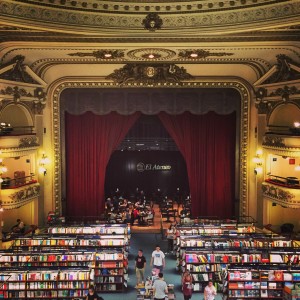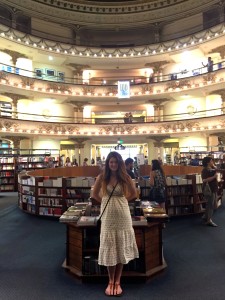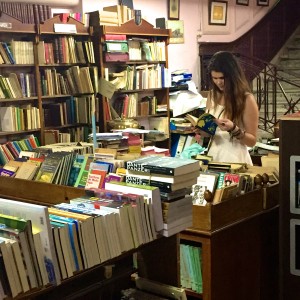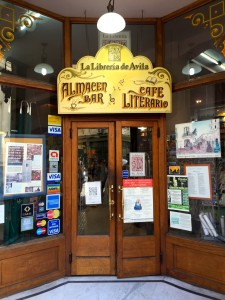I came to Argentina to be immersed in the rich and diverse culture, so why not immerse myself in it through the celebrated works of the country’s most esteemed writers? After all, they are the storytellers of this region, and it is through their eyes that we can best understand the history, struggles, and triumphs of Buenos Aires and her people. Although I haven’t even cracked open a book yet by Jorge Luis Borges or an anthology of poetry by Silvina Ocampo, I am so excited to be able to walk the streets and visit the buildings that inspired these renowned individuals.
However, just as much as the writers are important to a literary culture, so are the bookstores, libraries, and cultural centers that promote the work and bring people together through a common interest and understanding. Buenos Aires is home to over 800 bookstores, the majority of which are independently owned and frequently play host to literary events, readings, and signings; many even have in-house cafes and bars to attract a hungry crowd. These bookstores, called librerias, are often some of the primary locations where famous novels were written, and it is clear that there is a strong sense of place that resonates throughout each one.
I have made it my mission over the next several months to take a step back every once in a while from school and empanada-eating and assign a purpose to my exploratory walks around the city. I will visit each neighborhood in Buenos Aires, exploring the public landmarks and private entities that make up the thriving literary scene in the city, thus preparing myself to really dive into some of the best Latin American literature south of the Equator (I will always love my Gabriel Garcia Marquez, R.I.P.) and gain a deeper understanding for the beautiful city and country I will be living in.
So far I have made quite a few of the stops on my list, one of which being El Ateneo Grand Splendid, an enormous branch of a local chain bookstore housed in the old theater of the same name. The theater opened in 1919, and today the bookstore still features ceiling frescoes, a multi-level layout, and the beautiful red velvet stage curtains that now remain open to reveal a pricey but tasty cafe. On Santa Fe and Callao, it is definitely a worthy stop on a trip to Buenos Aires. It has the largest inventory of titles in the city, and its sheer size and sparkling beauty will make it hard to focus on whatever book is in front of you. It is indeed so large that I couldn’t locate the English language books, but there are rumors that it is hidden somewhere in the massive structure of the bookstore.


El Ateneo Grand Splendid is ranked the second most beautiful bookstore in the world, and it was just recently renovated from its previous state in 2000. Despite the novelty of El Ateneo, however, I was not nearly as impressed by it as I was with my visit to La Libreria de Avila, a block from La Plaza de Mayo in the historic center of Buenos Aires.
This bookstore caught my eye as our class tour was ending across the street, and rather than head back in the direction of school with the other students, I grabbed my boyfriend Karl by the hand and pulled him in with me. The shelves of La Libreria de Avila were full, littered at best with every genre of title imaginable. The books were a variety of new, used, extremely old, or extremely rare; if only you could imagine my delight when I came across a gaping hole in the floor with a balcony around it, exposing the basement level and even more books. At El Ateneo Grand Splendid I wanted to stroll the aisles, but here I wanted to dig into the shelves and discover the history behind all the old Gutenberg-bible-looking monster books, the tattered furniture that sufficed as comfortable reading space, and the strange old trinkets and games on display around the entirety of the store. This was curiosity, and it was exactly what I wanted to feel.


I picked out one of the only English titles I could find and sorted through my pesos to be sure I had enough. Upstairs at the checkout, I asked the cashier in my rusty Spanish about the history of the bookstore. I had just noticed it minutes ago from the street, but I could tell there was something special about it. He told me that in fact it was the oldest bookstore in Buenos Aires, and was one of the many locations where writers such as Jorge Luis Borges came to spend their afternoons with pen and ink. He continued on a bit more about the history of the building and the change in ownership of the store, most of which I didn’t catch.
His last statement caught me though, and I think it can epitomize why the literary scene here is so fascinating to me:
“Cuando no habia nada en Buenos Aires, habian libros.”
“When there was nothing in Buenos Aires, there were books.”
This is a literary city with deep historical roots that shape the stories that are told, and I can not think of a better way to spend my time here than to explore through the eyes of those who did the telling.
